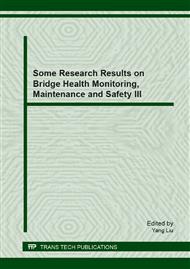p.1
p.11
p.21
p.31
p.43
p.53
p.67
p.77
Cracking Control for Diaphragm of Long-Span Prestressed Concrete Box Girder Bridge at the Early Age
Abstract:
This paper presents the results of a study on the early-age cracking behavior of diaphragm in long-span prestressed concrete box girder bridge with cracking control techniques. Based on the three-dimensional hydration heat temperature conduction and humidity diffusion theory, and according to the similarity of differential equation between the humidity diffusion theory and temperature conduction theory, the early-age cracking of diaphragm was simulated by a three-dimensional finite element model with consideration of concrete shrinkage, creep, cement hydration heat and variation of temperature. The numerical simulation accurately predicts the cracking region and size and stress time history of diaphragm, and provides load standard for cracking control techniques of prestressing force. The cracking control techniques of prestressing force effectively avoid the early-age cracking of diaphragm by application of practical engineering.
Info:
Periodical:
Pages:
1-9
Citation:
Online since:
September 2013
Authors:
Price:
Сopyright:
© 2014 Trans Tech Publications Ltd. All Rights Reserved
Share:
Citation:


